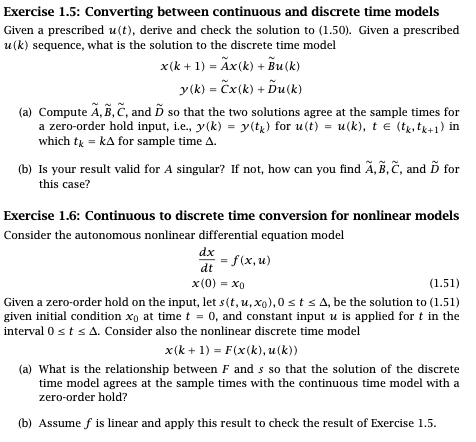Answered step by step
Verified Expert Solution
Question
1 Approved Answer
Exercise 1.5: Converting between continuous and discrete time models Given a prescribed u(t), derive and check the solution to (1.50). Given a prescribed u(k)

Exercise 1.5: Converting between continuous and discrete time models Given a prescribed u(t), derive and check the solution to (1.50). Given a prescribed u(k) sequence, what is the solution to the discrete time model x(k + 1) = Ax (k) + Bu(k) y(k) = x(k) + Du(k) (a) Compute A, B, C, and D so that the two solutions agree at the sample times for a zero-order hold input, i.e., y(k) = y(tk) for u(t) = u(k), t (tk, tk+1) in which tk =KA for sample time A. (b) Is your result valid for A singular? If not, how can you find A, B, C, and D for this case? Exercise 1.6: Continuous to discrete time conversion for nonlinear models Consider the autonomous nonlinear differential equation model dx dt = f(x,u) x(0) = x0 (1.51) Given a zero-order hold on the input, let s (t, u, xo), 0 ts A, be the solution to (1.51) given initial condition xo at time t = 0, and constant input u is applied for t in the interval 0 ts A. Consider also the nonlinear discrete time model x(k+1) = F(x(k), u(k)) (a) What is the relationship between F and s so that the solution of the discrete time model agrees at the sample times with the continuous time model with a zero-order hold? (b) Assume f is linear and apply this result to check the result of Exercise 1.5.
Step by Step Solution
There are 3 Steps involved in it
Step: 1

Get Instant Access to Expert-Tailored Solutions
See step-by-step solutions with expert insights and AI powered tools for academic success
Step: 2

Step: 3

Ace Your Homework with AI
Get the answers you need in no time with our AI-driven, step-by-step assistance
Get Started


